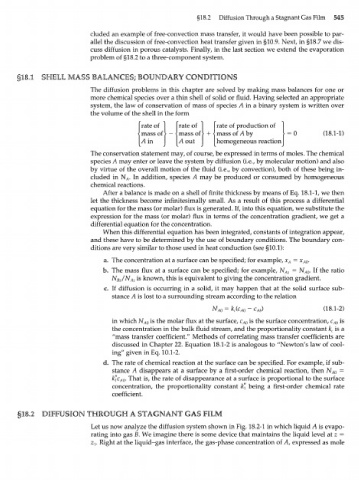Page 565 - Bird R.B. Transport phenomena
P. 565
§18.2 Diffusion Through a Stagnant Gas Film 545
eluded an example of free-convection mass transfer, it would have been possible to par-
allel the discussion of free-convection heat transfer given in §10.9. Next, in §18.7 we dis-
cuss diffusion in porous catalysts. Finally, in the last section we extend the evaporation
problem of §18.2 to a three-component system.
§18.1 SHELL MASS BALANCES; BOUNDARY CONDITIONS
The diffusion problems in this chapter are solved by making mass balances for one or
more chemical species over a thin shell of solid or fluid. Having selected an appropriate
system, the law of conservation of mass of species Л in a binary system is written over
the volume of the shell in the form
rate of I rate of I rate of production of
| mass of | - I mass of I + j mass of Л by 1 = 0 (18.1-1)
IЛ in I \A out I I homogeneous reaction I
The conservation statement may, of course, be expressed in terms of moles. The chemical
species A may enter or leave the system by diffusion (i.e., by molecular motion) and also
by virtue of the overall motion of the fluid (i.e., by convection), both of these being in-
cluded in N,4. In addition, species A may be produced or consumed by homogeneous
chemical reactions.
After a balance is made on a shell of finite thickness by means of Eq. 18.1-1, we then
let the thickness become infinitesimally small. As a result of this process a differential
equation for the mass (or molar) flux is generated. If, into this equation, we substitute the
expression for the mass (or molar) flux in terms of the concentration gradient, we get a
differential equation for the concentration.
When this differential equation has been integrated, constants of integration appear,
and these have to be determined by the use of boundary conditions. The boundary con-
ditions are very similar to those used in heat conduction (see §10.1):
a. The concentration at a surface can be specified; for example, x = x .
A A0
b. The mass flux at a surface can be specified; for example, N Az = N . If the ratio
A0
N /N Az is known, this is equivalent to giving the concentration gradient.
Bz
c. If diffusion is occurring in a solid, it may happen that at the solid surface sub-
stance A is lost to a surrounding stream according to the relation
N = K(c - c ) (18.1-2)
A0 A0 Ab
in which N is the molar flux at the surface, c is the surface concentration, c is
A0 A0 Ab
the concentration in the bulk fluid stream, and the proportionality constant k is a
c
"mass transfer coefficient/' Methods of correlating mass transfer coefficients are
discussed in Chapter 22. Equation 18.1-2 is analogous to "Newton's law of cool-
ing" given in Eq. 10.1-2.
d. The rate of chemical reaction at the surface can be specified. For example, if sub-
stance A disappears at a surface by a first-order chemical reaction, then N A0 =
k"c . That is, the rate of disappearance at a surface is proportional to the surface
A0
concentration, the proportionality constant k" being a first-order chemical rate
coefficient.
18„2 DIFFUSION THROUGH A STAGNANT GAS FILM
Let us now analyze the diffusion system shown in Fig. 18.2-1 in which liquid A is evapo-
rating into gas B. We imagine there is some device that maintains the liquid level at 2 =
z v Right at the liquid-gas interface, the gas-phase concentration of A, expressed as mole

